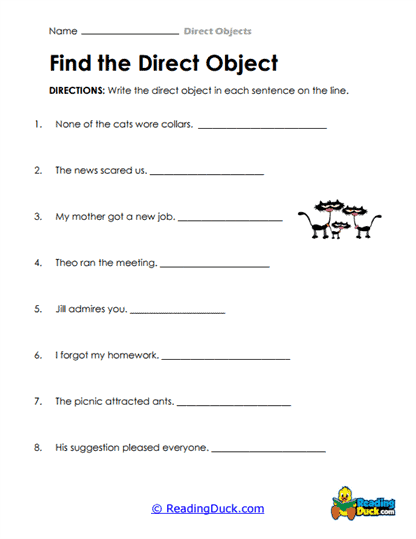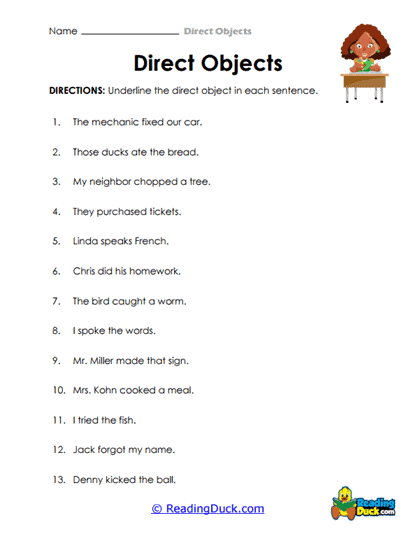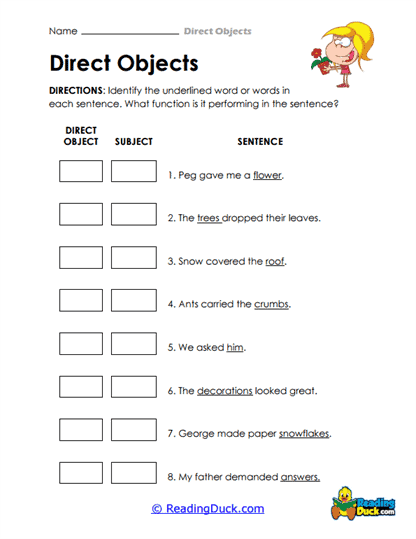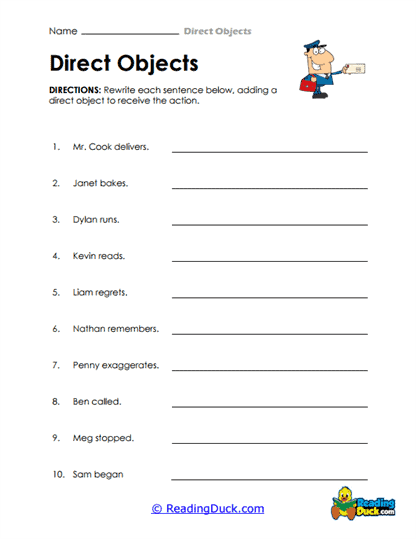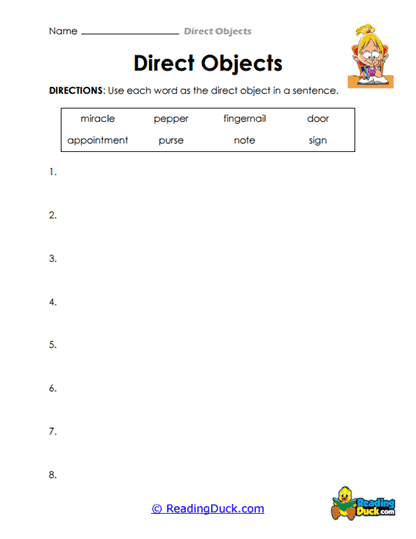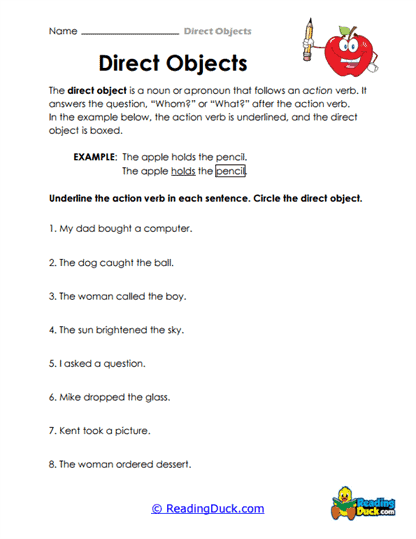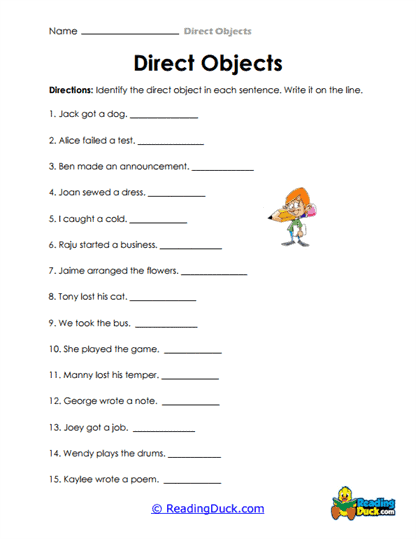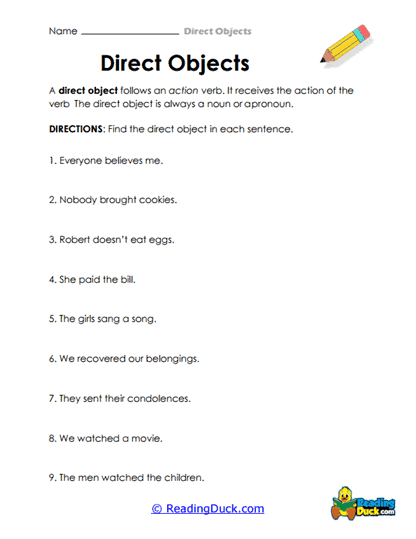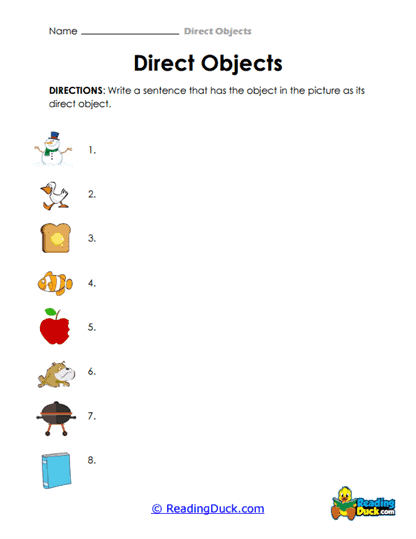Direct Objects Worksheets
About Our Direct Object Worksheets
Our Direct Objects Worksheets provide students with essential tools to strengthen their understanding of grammar, focusing on the identification and use of direct objects within sentences. Falling under the Grammar category within the Skills section, this collection is designed to build a strong foundation in sentence structure and improve overall language skills. Direct objects are crucial elements that students must grasp in order to write and speak effectively, as they clarify what or whom the action of a sentence is being performed upon.
These worksheets cover various aspects of direct objects, ensuring a thorough exploration of how they function in different contexts. Students will be able to recognize direct objects, place them accurately in sentences, and distinguish between direct objects and other sentence components. The worksheets come in PDF format, allowing for easy access, download, and printing. Additionally, each worksheet includes a downloadable answer key to enable self-assessment or teacher-led correction, further supporting students in their learning journey.
What Are Direct Objects? A Complete Explanation
Direct objects are an integral part of sentence structure, providing clarity and meaning by identifying the recipient of the action in a sentence. Without direct objects, sentences would often feel incomplete or ambiguous, leaving the reader or listener wondering what the action affects.
Definition of Direct Objects:
A direct object is a noun, pronoun, or noun phrase that receives the action of a verb. It answers the question "what?" or "whom?" in relation to the verb. For example, in the sentence "She threw the ball," the verb is "threw," and the direct object is "the ball," which answers the question "What did she throw?"
How to Identify a Direct Object
Locate the Action Verb:
-
- Start by finding the action verb in the sentence, as the direct object will be the recipient of this action.
- Example: "They ate the pizza." The action verb is "ate."
Ask the Question “What?” or “Whom?”:
-
- To find the direct object, ask "what?" or "whom?" after the verb.
- Example: "They ate what?" The answer is "the pizza," which makes "pizza" the direct object.
Types of Direct Objects
Single Noun Direct Objects:
-
- A direct object can be a single noun that receives the action of the verb.
- Example: "The teacher called Tom."
- "Tom" is the direct object because he is the one receiving the action of the verb "called."
Pronoun Direct Objects:
-
- A direct object can also be a pronoun.
- Example: "The manager thanked her."
- Here, "her" is the direct object.
Direct Object Phrases:
-
- Sometimes, the direct object may be a noun phrase that includes more than one word.
- Example: "He bought a new computer."
- "A new computer" is the complete noun phrase acting as the direct object.
Direct Objects in Compound Sentences:
-
- A compound sentence may have multiple direct objects connected by conjunctions like and or or.
- Example: "She baked cookies and cake for the party."
- Both "cookies" and "cake" are direct objects because they receive the action of the verb "baked."
Direct Objects vs. Other Sentence Elements: Direct objects should not be confused with other parts of a sentence, such as indirect objects or subject complements. Indirect objects answer the question "to whom?" or "for whom?" the action is performed, while subject complements describe or rename the subject. In the sentence "He gave her the book," "her" is the indirect object, and "the book" is the direct object.
Effective Methods for Teaching Direct Objects
When introducing direct objects to students, educators can utilize a variety of methods to make the concept clear and engaging. These approaches help students not only understand direct objects but also see how they function in everyday language.
Start with Simple Sentences: Begin with simple, clear sentences where the direct object is easy to identify. Focusing on basic examples like "The cat chased the mouse" allows students to grasp the concept without the complexity of indirect objects or compound sentences.
-
- Example: Ask students to identify the direct object in "John ate the sandwich." They can easily spot that "sandwich" is the direct object receiving the action.
Highlight the Verb First: Guide students by first locating the verb in a sentence. Once they know what action is happening, it becomes easier to find what or whom that action is affecting.
-
- Technique: Encourage students to underline the verb and then ask themselves "what?" or "whom?" to find the direct object.
Use Visual Aids: Charts or diagrams that break down sentence structure can be helpful for visual learners. Creating a simple chart with columns labeled “Subject,” “Verb,” and “Direct Object” allows students to see how each element fits into a sentence.
Interactive Sentence Building: Have students create their own sentences, starting with a subject and verb, and then add different direct objects. This hands-on approach allows students to practice inserting direct objects into various sentence structures.
By progressively building on these techniques, students can develop a solid grasp of direct objects and their role in sentence construction.
Addressing Common Difficulties in Learning Direct Objects
Students may face several challenges when first learning about direct objects, especially when trying to distinguish them from other parts of the sentence or when working with more complex sentence structures.
Challenge: Confusing Direct and Indirect Objects:
-
- Students often mix up direct objects with indirect objects, especially in sentences that contain both.
- Solution: Teach students to first locate the direct object by asking "what?" or "whom?" in relation to the verb. Then, if applicable, identify the indirect object by asking "to whom?" or "for whom?" For example, in "She gave him the book," "book" is the direct object, and "him" is the indirect object.
Challenge: Identifying Direct Objects in Passive Voice:
-
- In passive sentences, the direct object often becomes the subject, making it harder for students to recognize.
- Solution: Clarify the difference between active and passive voice, and practice converting passive sentences back into active form. For instance, "The cake was eaten by the dog" becomes "The dog ate the cake," making it easier to spot "cake" as the direct object.
Challenge: Direct Objects in Complex Sentences:
-
- Longer sentences with multiple clauses can make it difficult to locate direct objects.
- Solution: Break the sentence down into smaller parts and focus on one clause at a time. For example, in "She said that he found the keys," "found the keys" is the main clause with "keys" as the direct object.
By addressing these challenges with clear examples and practice, students can overcome confusion and master the use of direct objects.
Engaging Activities for Reinforcing Direct Object Skills
Incorporating creative activities into grammar lessons helps students practice direct objects in a more engaging and interactive way. These activities can be used in both classroom and homeschool settings, making them versatile tools for reinforcing the topic.
- Direct Object Scavenger Hunt (Grades 2-4): Create a scavenger hunt where students search through a text to find sentences with direct objects. They can highlight the direct object and share their findings with the class. This activity makes identifying direct objects an active process.
- Sentence Crafting Challenge (Grades 3-5): Ask students to write their own sentences using direct objects from a list of nouns you provide. Encourage them to share their sentences with peers and identify the direct objects in each other’s work. This collaborative activity helps solidify their understanding.
- Direct Object Relay Game (Grades 3-6): Divide the class into teams and have students race to the board to write sentences with a clear subject, verb, and direct object. The team that writes the most correct sentences within a time limit wins. This adds a competitive element while reinforcing sentence structure.
- Story Writing with Direct Objects (Grades 4-6): Have students write short stories where each sentence must contain a direct object. Afterward, students can exchange stories and identify the direct objects in each other’s writing. This activity encourages creativity while practicing grammar skills.
The Importance of Learning Direct Objects
Understanding direct objects is crucial for constructing clear and meaningful sentences. Direct objects provide the detail needed to complete a sentence’s action and are essential for both written and spoken communication. Mastering direct objects helps students develop stronger sentence structure skills, which in turn improves their overall writing ability and clarity.
In real-life situations, recognizing direct objects aids in more effective communication, whether in writing essays, telling stories, or even following instructions. As students progress in their language learning, a solid understanding of direct objects will enhance their ability to express ideas with precision and confidence. Through consistent practice, the skills developed by working with direct objects will serve students in both academic and everyday contexts.
